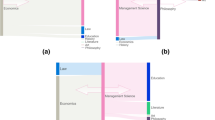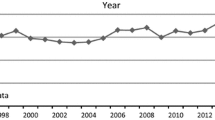Abstract
Metaphors play a crucial role in facilitating the comprehension and analysis of knowledge. “Knowledge as energy” is a well-established metaphorical framework that provides unique benefits for comprehending the dissemination of knowledge and enabling its quantification. Nevertheless, empirical studies employing this framework are limited, especially in the area of the work–energy metaphor, which primarily remains theoretical. This paper proposes an application scheme for the work– energy metaphor in interdisciplinary citation analysis. In this scheme, disciplines are considered entities; various factors that drive the progress of a discipline are considered forces; energy is considered the knowledge produced or transferred in the citations. Building upon the work–energy theorem in physics, this study developed indicators reflecting citation quality and velocity to assess interdisciplinary research progression. An empirical investigation was carried out, utilizing these indicators to evaluate the influence of interdisciplinary citations on disciplines. In the experiments, we used Library and Information Science (LIS) from 2012 to 2021 as an example to analyze the impact of interdisciplinary citations from LIS on other disciplines over two time periods. The experiments demonstrated the feasibility of the work–energy metaphorical framework proposed in this paper. It was also found that Computer Science, Management, and Business experienced the highest impact from LIS interdisciplinary citations and exhibited steady growth over a 10-year period. Environmental Science has substantial potential for the future.



Similar content being viewed by others
References
Andriessen, D. G. (2008). Stuff or love? How metaphors direct our efforts to manage knowledge in organisations. Knowledge Management Research & Practice, 6(1), 5–12. https://doi.org/10.1057/palgrave.kmrp.8500169
Bratianu, C., & Andriessen, D. (2008). Knowledge as energy: A metaphorical analysis. In: Harorimana, D. & Watkins, D. (Eds.), Proceedings of the 9th European conference on knowledge management (75). 9th European Conference on Knowledge Management.
Brillouin, L. (1956). Science and information theory. Academic Press.
Chen, W. (2010). A discussing on the mechanism of knowledge transfer from physics perspective: To interpret knowledge flow from the viewpoint of knowledge potential difference. Science Technology and Industry, 10(01), 110–113.
Huang, L., Cai, Y. J., Zhao, E. D., Zhang, S. T., Shu, Y., & Fan, J. (2022). Measuring the interdisciplinarity of Information and Library Science interactions using citation analysis and semantic analysis. Scientometrics, 127(11), 6733–6761. https://doi.org/10.1007/s11192-022-04401-x
Huang, Y., Gao, T., Wang, Z., Wang, X., Porter, A. L., & Zhu, D. (2016). Interdisciplinary measurement research based on Web of Science classification. Science Research Management, 37(3), 124–132.
Kwon, S., Youtie, J., & Porter, A. L. (2021). Interdisciplinary knowledge combinations and emerging technological topics: Implications for reducing uncertainties in research evaluation. Research Evaluation, 30(1), 127–140. https://doi.org/10.1093/reseval/rvaa029
Ledford, H. (2015). How to solve the world’s biggest problems. Nature, 525(7569), 308–311. https://doi.org/10.1038/525308a
Li, C. L., Rong, G. Y., Shen, L. X., & Liu, C. (2022). Disciplinary kinetic energy theory and its application in the evaluation of subject influence. Library and Information Service, 66(23), 4–12. https://doi.org/10.13266/j.issn.0252-3116.2022.23.001
Lyu, H. H., & Li, J. (2021). An investigation of interdisciplinary knowledge flow from 1987 to 2016: A new perspective of “Disciplinary Potential Energy.” Document, Information & Knowledge, 38(04), 125–135.
Ma, F., & Chen, B. (2015). Study of discipline diversity in the field of chinese humanities and social sciences. Information Science, 33(04), 3–8. https://doi.org/10.13833/j.cnki.is.2015.04.003
National Academy of Sciences, National Academy of Engineering, & Institute of Medicine. (2005). Facilitating interdisciplinary research. The National Academies Press.
Porter, A. L., & Chubin, D. E. (1985). An indicator of cross-disciplinary research. Scientometrics, 8(3–4), 161–176. https://doi.org/10.1007/BF02016934
Porter, A. L., & Rafols, I. (2009). Is science becoming more interdisciplinary? Measuring and mapping six research fields over time. Scientometrics, 81(3), 719–745. https://doi.org/10.1007/s11192-008-2197-2
Prathap, G. (2011a). A thermodynamic explanation for the Glanzel–Schubert model for the h-index. Journal of the American Society for Information Science and Technology, 62(5), 992–994. https://doi.org/10.1002/asi.21508
Prathap, G. (2011b). The energy-exergy-entropy (or EEE) sequences in bibliometric assessment. Scientometrics, 87(3), 515–524. https://doi.org/10.1007/s11192-011-0367-0
Prathap, G. (2014). Quantity, quality, and consistency as bibliometric indicators. Journal of the Association for Information Science and Technology, 65(1), 214. https://doi.org/10.1002/asi.23008
Prathap, G., & Rousseau, R. (2023). The modified repeat rate described within a thermodynamic framework. Scientometrics, 128(5), 3185–3195. https://doi.org/10.1007/s11192-023-04698-2
Rafols, I., & Meyer, M. (2010). Diversity and network coherence as indicators of interdisciplinarity: Case studies in bionanoscience. Scientometrics, 82(2), 263–287. https://doi.org/10.1007/s11192-009-0041-y
Rylance, R. (2015). Grant giving: Global funders to focus on interdisciplinarity. Nature, 525(7569), 313–315. https://doi.org/10.1038/525313a
Steele, T. W., & Stier, J. C. (2000). The impact of interdisciplinary research in the environmental sciences: A forestry case study. Journal of the American Society for Information Science, 51(5), 476–484. https://doi.org/10.1002/(SICI)1097-4571(2000)51:5%3c476::AID-ASI8%3e3.0.CO;2-G
Stirling, A. (2007). A general framework for analysing diversity in science, technology and society. Journal of the Royal Society Interface, 4(15), 707–719. https://doi.org/10.1098/rsif.2007.0213
Zeng, B., Lyu, H. H., Zhao, Z. Y., & Li, J. (2021). Exploring the direction and diversity of interdisciplinary knowledge diffusion: A case study of professor Zeyuan Liu’s scientific publications. Scientometrics, 126(7), 6253–6272. https://doi.org/10.1007/s11192-021-03886-2
Zhang, H., Xu, H., Yue, Z., & Liu, C. (2019). Research on the influence evaluation method of interdisciplinary journals. Journal of the China Society for Scientific and Technical Information, 38(10), 1030–1040.
Acknowledgements
The research described in this paper is supported by the National Social Science Found of China (No.23BTQ053 and No.19VXK09).
Author information
Authors and Affiliations
Contributions
Guoyang Rong conceived of the method in this paper, led the data processing, and wrote a draft. Changling Li provided key guidance on the paper’s concept, research methodology, and writing. Zhijian Zhang and Shuaipu Chen assisted with the coding for data processing. Yuxing Qian helped with editing and revising the manuscript.
Corresponding authors
Ethics declarations
Conflict of interest
The authors have no competing interests to declare that are relevant to the content of this article.
Additional information
Publisher's Note
Springer Nature remains neutral with regard to jurisdictional claims in published maps and institutional affiliations.
Rights and permissions
Springer Nature or its licensor (e.g. a society or other partner) holds exclusive rights to this article under a publishing agreement with the author(s) or other rightsholder(s); author self-archiving of the accepted manuscript version of this article is solely governed by the terms of such publishing agreement and applicable law.
About this article
Cite this article
Rong, G., Li, C., Zhang, Z. et al. Investigating the application of work–energy metaphor in interdisciplinary citation analysis. Scientometrics 129, 3573–3591 (2024). https://doi.org/10.1007/s11192-024-05019-x
Received:
Accepted:
Published:
Issue Date:
DOI: https://doi.org/10.1007/s11192-024-05019-x




